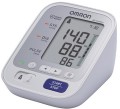Pressure measuring range
The effective measurement range of a blood pressure monitor covers both "upper" and "lower" pressure values. Most modern devices have a lower limit within 0-20 mm Hg, which is adequate for the majority of cases. As for the upper limit, a device with a maximum value of 180 mm Hg is generally sufficient for individuals without a history of significant blood pressure spikes until old age or without serious illnesses. However, for those prone to substantial increases, it's advisable to consider devices with higher upper limit values, which can reach up to 280 mm Hg in modern blood pressure monitors.
Pulse measurement range
The blood pressure monitor's pulse rate measurement capability typically falls within a range of 30-40 to 180 beats per minute. While extending the lower limit is unnecessary for household blood pressure monitors, a higher upper limit may be essential for measurements during intense physical activity or for individuals with conditions causing significant heart rate acceleration, such as tachycardia.
Cuff dimensions
The cuff's applicable range includes both the minimum and
maximum circumferences of the upper arm or wrist (see "Place of measurement"). Modern blood pressure monitors typically feature cuffs suitable for individuals with average physique, covering the majority of adult patients. However, for specialized cases, such as monitoring a child or someone with a larger bicep circumference, it is advisable to measure the arm circumference and compare it with the specified cuff sizes.
—
Small. The small cuffs are designed for a shoulder girth of 17-22 cm.
—
Standard. Standard cuffs cover a shoulder girth of 22-32 cm.
—
Oversized. Oversized cuffs have a girth of 22-36 cm.
—
Universal. Cuffs for both thin and large people. Universal cuffs provide a shoulder girth of 22-42 cm.
—
Large. Large cuffs with a girth of 33-46 cm are suitable for a full arm or a muscular shoulder of a conditional bodybuilder.
In box
—
Additional cuff. The blood pressure monitor set includes two cuffs, main and auxiliary, which differ from each other only in standard size. Usually, the auxiliary cuff has a longer length. For example, if the length of the main cuff is 22-36 cm, then the auxiliary cuff will be one size larger, that is, 30-42 cm. An additional larger cuff allows you to expand the circle of users of the blood pressure monitor.
—
Power source. Blood pressure monitors with a power supply option can operate using a 230 V household power supply, eliminating the need for frequent battery replacements. Interestingly, many of these monitors also come equipped with batteries, providing users flexibility in choosing the power source for the measuring device.
—
Cover/case. The blood pressure monitor comes with a dedicated bag for convenient storage and transportation of all its components. Depending on the tonometer's configuration, the case can accommodate the device, primary and auxiliary cuffs, a stethoscope, spare batteries, a power supply, and instructions. Some cases even include an extra compartment for storing medications. Typically, the tonometer bag is soft.
— Batteries. The blood pressure monitor operates on replaceable batteries, commonly using AA or AAA batteries. This battery-powered design makes the device self-contained, allowing its use in remo
...te locations or while traveling without access to a household electrical outlet. However, a drawback of battery-powered blood pressure monitors is the requirement for regular battery replacement or recharging.
